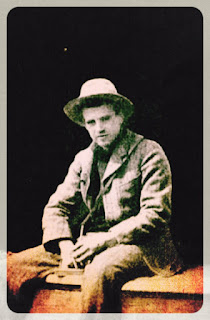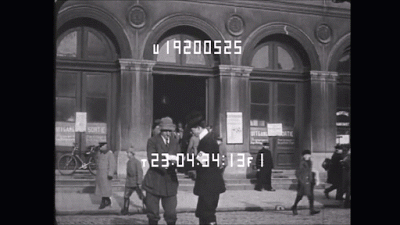Among the American journalists reporting on World War I Robert S. Dunn deserves a special note of interest. Born in Newport, Rhode Island, in 1877, Dunn was an explorer and naval officer whose interests carried him into many corners of the world. After his graduation from Harvard in 1898, he travelled the Yukon Trail to the Klondike and became a journalist upon his return.
 |
Robert S. Dunn (1903)
|
In 1908 Dunn led the first climbing party that reached the top of Mt. Wrangell, Alaska. As a war correspondent he covered the Russo-Japanese War, the attack by the US Marines on Veracruz and General Pershing's expedition into Mexico against Pancho Villa. During World War I he was a correspondent for the
New York Post. Dunn described his war experiences in his book
Five Fronts - On the Firing Lines with English, French, Austrian, German and Russian Troops (1915).
Official Film Report
As mentioned in a
previous weblog, the German government in January 1915 produced a film on the living conditions in occupied Belgium. American cameraman Albert K. Dawson and Austrian newsreel photographer Hans Theyer were assigned to accompany Dunn and a group of fellow American reporters, including Jack Reed, to make an official film. The film project was set up to show the world that the Belgian people were treated decently, thus trying to disprove the stories on atrocities committed by German soldiers in Belgium. Scenes from this movie were found by the authors while researching our book
American Cinematographers in the Great War. You can read more on this historic film in our latest book.
 |
German frontline in the Argonne forest, photographed by Albert Dawson, January/February 1915
|
 |
Albert Dawson (right), with a fellow American correspondent in Brussels, January/February 1915
|
Cameramen under Fire
Like Reed, Dunn mentioned the film coverage of their 1915 trench trip in his book
Five Fronts. Here is how he described Dawson's and Theyer's frantic return from the frontline after they had just filmed a terrifying French artillery barrage near Comines:
Comines lies just across the old French frontier, in Belgium. We had luncheon with our generous corps' staff, in some residence all dark with ambrequins and terra cotta plaques. It was the usual officers' mess - the long table lined with mystifying uniforms, bantering one another but carefully gracious to you; boiled meats to eat, yet more of the wine of the country than beer. And that our hosts were all-Bavarian was plain from the captain on my right, who had been to Oxford, and was willing enough to admit in argument the social and economic dangers of a military hierarchy. Consider that, from a hide-bound German soldier, on the edge of battle!
Three o'clock found us threading the narrow streets of Houthem, the divisional headquarters, and a stage nearer the inferno of the trenches. Already any windows left in the village were rattling to the detonations of shrapnel; their sudden spawning white plumes over the long rise west of the town made the woods on its crest seem alive. The place itself was shelled nearly every afternoon. A few more house size holes in its walls and roof, and the brick church de l'Assomption would be no more. We climbed the belfry, but only to see a shattered Norman church, with a rooster weathervane and a wrecked village rise from the crest of woods. Between and beyond these, the German cross-fire over the invisible French trenches yonder appeared to meet, in white spurts like two streams of cloud sped from separate air currents and waxing furious, brought out a hundering answer from the French batteries further north.
On the ground again by the divisional station, two soldiers came down the road from that quarter carrying an elegant new coffin on their shoulders. And behind them tooted the motor-car that had taken our official cinema men [Dawson and Theyer] to the artillery up there. Exactly what had happened, the counter insinuations in the pair's stories only fogged. A shrapnel shell — or a grenade — had exploded in the air or hit the ground ten up to a hundred yards away. Somebody had dropped his [movie] machine and run, but some one else had skipped out first, while No. 2 had fled only because No. 1 wouldn't stand his ground while he had shouted to him, thought he had, et cetera. One boasted of a splash of mud hurled against his back, which was quite clean, both where he could and couldn't see it. They agreed only in their breathless resolve to hustle back to Comines, with the twenty feet of film that the first peep of sun in a week had vouchsafed them.
In 1918 Dunn was commissioned an officer in the U.S. Navy, and served as an intelligence officer in London and in Constantinople. During his later years, he concentrated on horticulture and on writing in his home in Katonah, New York. He wrote two published novels,
Youngest World and
Horizon Fever and one book of verse. Dunn's autobiography was published in 1956 after his death.
Robert Dunn's book On Five Fronts (1915) can be read and downloaded here.



No comments:
Post a Comment
Note: Only a member of this blog may post a comment.